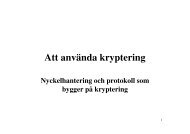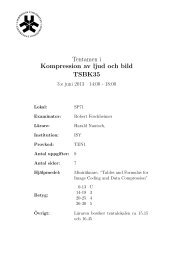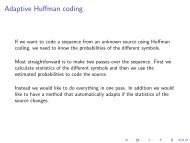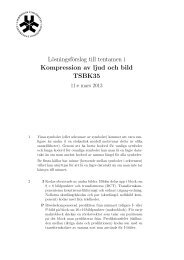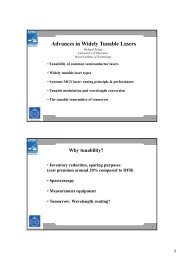Arithmetic coding of Markov source, example
Arithmetic coding of Markov source, example
Arithmetic coding of Markov source, example
Create successful ePaper yourself
Turn your PDF publications into a flip-book with our unique Google optimized e-Paper software.
<strong>Arithmetic</strong> <strong>coding</strong> <strong>of</strong> <strong>Markov</strong> <strong>source</strong>, <strong>example</strong>ProblemA <strong>Markov</strong> <strong>source</strong> X i <strong>of</strong> order 2 with alphabet A = {1, 2} is given by thetransition probabilities p(x i |x i−1 , x i−2 ) below (note the order).Code the sequencep(1|1, 1) = 0.95 p(2|1, 1) = 0.05p(1|1, 2) = 0.9 p(2|1, 2) = 0.1p(1|2, 1) = 0.2 p(2|2, 1) = 0.8p(1|2, 2) = 0.3 p(2|2, 2) = 0.7122111using arithmetic <strong>coding</strong>. The memory <strong>of</strong> the <strong>source</strong> should be utilized. Youcan assume that the <strong>source</strong> is in state (1,1) when the <strong>coding</strong> starts. You canalso assume that the coder can store all probabilities and interval limits exactly.Give both the resulting interval and the codeword.SolutionWe will have four cumulative distribution functions F (x i |x i−1 , x i−2 ), given byStarting intervalF (0|1, 1) = 0 F (1|1, 1) = 0.95 F (2|1, 1) = 1F (0|1, 1) = 0 F (1|1, 2) = 0.9 F (2|1, 2) = 1F (0|1, 1) = 0 F (1|2, 1) = 0.2 F (2|2, 1) = 1F (0|1, 1) = 0 F (1|2, 2) = 0.3 F (2|2, 2) = 1First symbol is 1, state is (1,1).Second symbol is 2, state is (1,1).l (0) = 0u (0) = 1l (1) = 0 + (1 − 0) · F (0|1, 1) = 0u (1) = 0 + (1 − 0) · F (1|1, 1) = 0.95l (2) = 0 + (0.95 − 0) · F (1|1, 1) = 0.9025u (2) = 0 + (0.95 − 0) · F (2|1, 1) = 0.951
Third symbol is 2, state is (2,1).l (3) = 0.9025 + (0.95 − 0.9025) · F (1|2, 1) = 0.912u (3) = 0.9025 + (0.95 − 0.9025) · F (2|2, 1) = 0.95Fourth symbol is 1, state is (2,2).l (4) = 0.912 + (0.95 − 0.912) · F (0|2, 2) = 0.912u (4) = 0.912 + (0.95 − 0.912) · F (1|2, 2) = 0.9234Fifth symbol is 1, state is (1,2).l (5) = 0.912 + (0.9234 − 0.912) · F (0|1, 2) = 0.912u (5) = 0.912 + (0.9234 − 0.912) · F (1|1, 2) = 0.92226Sixth symbol is 1, state is (1,1).l (6) = 0.912 + (0.92226 − 0.912) · F (0|1, 1) = 0.912u (6) = 0.912 + (0.92226 − 0.912) · F (1|1, 1) = 0.921747The interval corresponding to the sequence is [0.912 0.921747) with interval size0.009747. We will thus need at least ⌈− log 2 0.009747⌉ = 7 bits in our codeword,maybe one more.Write the two interval limits as binary numbers:0.912 = 0.11101001011110 . . .0.921747 = 0.11101011111101 . . .From this it is clear that there are no seven bit numbers such that all numbersstarting with these seven bits are inside the interval. Thus, we will have to useeight bits in our codeword. Our codeword becomes 111010102




